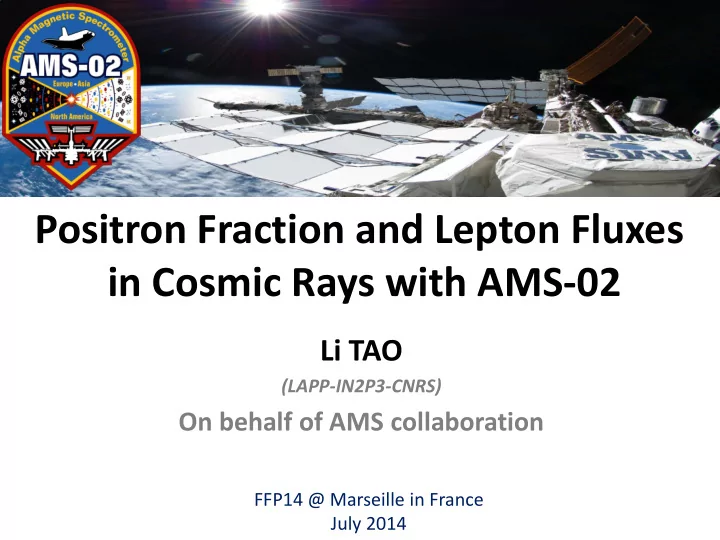

Positron Fraction and Lepton Fluxes in Cosmic Rays with AMS-02 Li TAO (LAPP-IN2P3-CNRS) On behalf of AMS collaboration FFP14 @ Marseille in France July 2014
Our goals With AMS, we search for primodial antimatter and evidence of dark matter; we refine the propagation models. Electrons constitute 1% of the cosmic ray particles. Positron identification requires proton rejection power of 10 4 . 2
Overview of the AMS Detector trigger 0.14T 3
Data Acquisition Since May 2011 Trigger Rate (Hz) The trigger rates vary from DAQ efficiency reaches 90% 200 to 2000 Hz per orbit (South Atlantic Anomaly excluded) 50 billion events have been collected in the past 3 years. 4
Electron Identification Electron event @ 1.03TeV Proton rejection Charge Z Velocity β Electron Charge Z Selection Sign of the charge Momentum P Electron energy E Proton rejection 5
Proton Rejection TRD @ 90% e+ efficiency 6
Electron Number Count Number of leptons and positrons extracted from fitting data with electron and proton templates Templates obtained from data Electron and proton templates well separated using ECAL and TRD estimators ECAL estimator fit Lepton sample TRD estimator fit Positron sample Positrons 173-206 GeV 7 Z.WENG and V.Vagelli @ ICHEP 2014
Charge Confusion Charge confusion estimator developped using tracker information Other estimators such as E/P Charge confusion obtained by simultaneously fitting with electron/proton estimator 8
Charge Confusion Good agreement between MC prediction and Data measurement Method BDT Method E/P 9
Positron Fraction (2014 @ ICHEP) • Energy range extended to 500 GeV • Improved accuracy compared to PRL result 2013 • ~72 positrons for the last bin: σ stat. 0.028, σ syst. 0.019 10
Positron fraction E s = 𝐹 𝑡 = 540+250 −130𝐻𝑓𝑊 2013 2014 Diffuse power law and source terms are used to describe the behaviour of positron fraction 11
Flux Measurement Procedure 𝑶 𝒕𝒋𝒉𝒐𝒃𝒎 𝜲(𝑭, 𝑭 + ∆𝑭) = Isotropic flux: 𝑩 𝒉𝒇𝒑 ∗ 𝜻 𝒕𝒇𝒎. ∗ 𝜻 𝒖𝒔𝒋𝒉. ∗ 𝑼 𝒇𝒚𝒒𝒑 (𝑭) ∗ 𝜠𝑭 MC Acceptance & Selection efficiency MC • calculated with MC • corrected with data Systematic uncertainties: • 2-3% from acceptance • 2% from energy measurement 12
Trigger Efficiency 𝐎 𝐪𝐢𝐳𝐭.𝐮𝐬𝐣𝐡. 𝑭𝒎𝒇𝒅𝒖𝒔𝒑𝒐𝒕: 𝛇 𝐮𝐬𝐣𝐡. = 𝐎 𝐪𝐢𝐳𝐭.𝐮𝐬𝐣𝐡 + 𝐠 𝐪𝐬𝐟𝐭𝐝𝐛𝐦𝐟 × 𝐎 𝐯𝐨𝐜𝐣𝐛𝐭 Efficiency 100% from 5 GeV 13
Exposure Time 𝐎 𝐔 𝐟𝐲𝐪𝐩 (𝐅) = 𝐌𝐣𝐰𝐟𝐔𝐣𝐧𝐟 ∗ 𝐈(𝐅 − 𝐠 ∗ 𝐒 𝐍𝐛𝐲𝐝𝐯𝐮𝐩𝐠𝐠 ) 𝟏 H(x) is the Heaviside step function R cutoff is the geomagnetic cutoff value, f the safety factor 14
Electron Flux (2014 @ ICHEP) 15
Positron Flux (2014 @ ICHEP) 16
Combined e + +e - Flux (2014@ICHEP) 17
Conclusion AMS has been performing smoothly for more than 3 years. 30 months of data have been analyzed. 11 million positrons and electrons The combination of TRD and ECAL achieves a proton rejection power of 10 4 . Latest AMS results are presented: Positron fraction up to 500 GeV Electron flux up to 700 GeV Positron flux up to 500 GeV Combined positron and electron flux up to 1 TeV 18
ECAL Resolution 17 X 0 19
Charge Confusion: E/P method 20
DM origin of positron fraction rise 21
Pulsar origin of the positron fraction rise 22
23
24
25
Recommend
More recommend